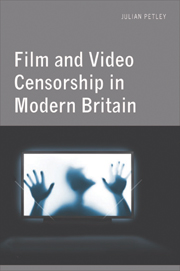Part III - Nineties Nightmares
Published online by Cambridge University Press: 05 August 2013
Summary
This part of the book shows the BBFC at work in the 1990s, and covers James Ferman's last decade as its Director. Chapter 9 and the last part of Chapter 7 attempt to illustrate Ferman's somewhat idiosyncratic modus operandi, and suggest that at least some of the Board's problems in this decade were partly a result of his high-handedness and his pronounced tendency to sit on potentially troublesome films and videos in the hope that the problems which they apparently posed would somehow defuse themselves, whereas all too often – as in the case of Crash, for example – the lid finally blew off the pressure cooker in which a row had been slowly steaming away. But this part of the book, like the two preceding parts, also argues that the Board's activities cannot be explained simply in terms of its own internal dynamics or of the characteristics of its leading personnel, but need to be understood as being acted upon by various external factors. Crucial in this respect are the laws of the land (especially the Video Recordings Act and Obscene Publications Act) and how these are enforced by the police and the Crown Prosecution Service and interpreted by judges and magistrates, and the activities of politicians, who make those laws in the first place and also have the power to de-designate the BBFC as the body responsible for enforcing the Video Recordings Act.
- Type
- Chapter
- Information
- Film and Video Censorship in Modern Britain , pp. 81 - 86Publisher: Edinburgh University PressPrint publication year: 2011

